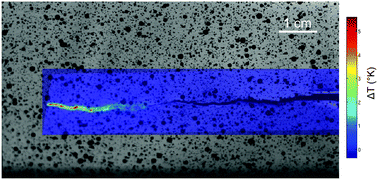How cracks are hot and cool: a burning issue for paper†
Abstract
Material failure is accompanied by important heat exchange, with extremely high temperature – thousands of degrees – reached at crack tips. Such a temperature may subsequently alter the mechanical properties of stressed solids, and finally facilitate their rupture. Thermal runaway weakening processes could indeed explain stick-slip motions and even be responsible for deep earthquakes. Therefore, to better understand catastrophic rupture events, it appears crucial to establish an accurate energy budget of fracture propagation from a clear measure of various energy dissipation sources. In this work, combining analytical calculations and numerical simulations, we directly relate the temperature field around a moving crack tip to the part α of mechanical energy converted into heat. By monitoring the slow crack growth in paper sheets using an infrared camera, we measure a significant fraction α = 12% ± 4%. Besides, we show that (self-generated) heat accumulation could weaken our samples by microfiber combustion, and lead to a fast crack/dynamic failure/regime.


 Please wait while we load your content...
Please wait while we load your content...